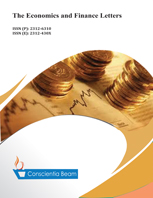Export- Led Growth Hypothesis for Ghana: A TVAR & TVECM Analysis
DOI:
https://doi.org/10.18488/journal.29.2020.72.92.103Abstract
This study employs threshold models to examine the export-led growth hypothesis (ELG) for Ghana from 1970-2018. The analysis commences as follows. Firstly, using real GDP as threshold variable, the study conducts a non-linearity test for the threshold vector autoregressive (TVAR) model as against the linear vector autoregressive (VAR) model. Secondly, the study evaluates whether the ELG hypothesis is best explained with linear co-integration models or threshold co-integration models. The empirical results indicate that, the ELG hypothesis is supported by the two-threshold vector autoregressive model (threshold values of 2.35 and 2.46) and a two-threshold vector error correction model (threshold values -0.50 and -0.20). The error correction term of the TVECM is negative and statistically different from zero, signifying speed of long run convergence. In terms of threshold co-integration, real GDP versus real exports and real GDP vs real imports are threshold co-integrated. In contrast, the null hypothesis of linear co-integration is not rejected for real export versus real import.

